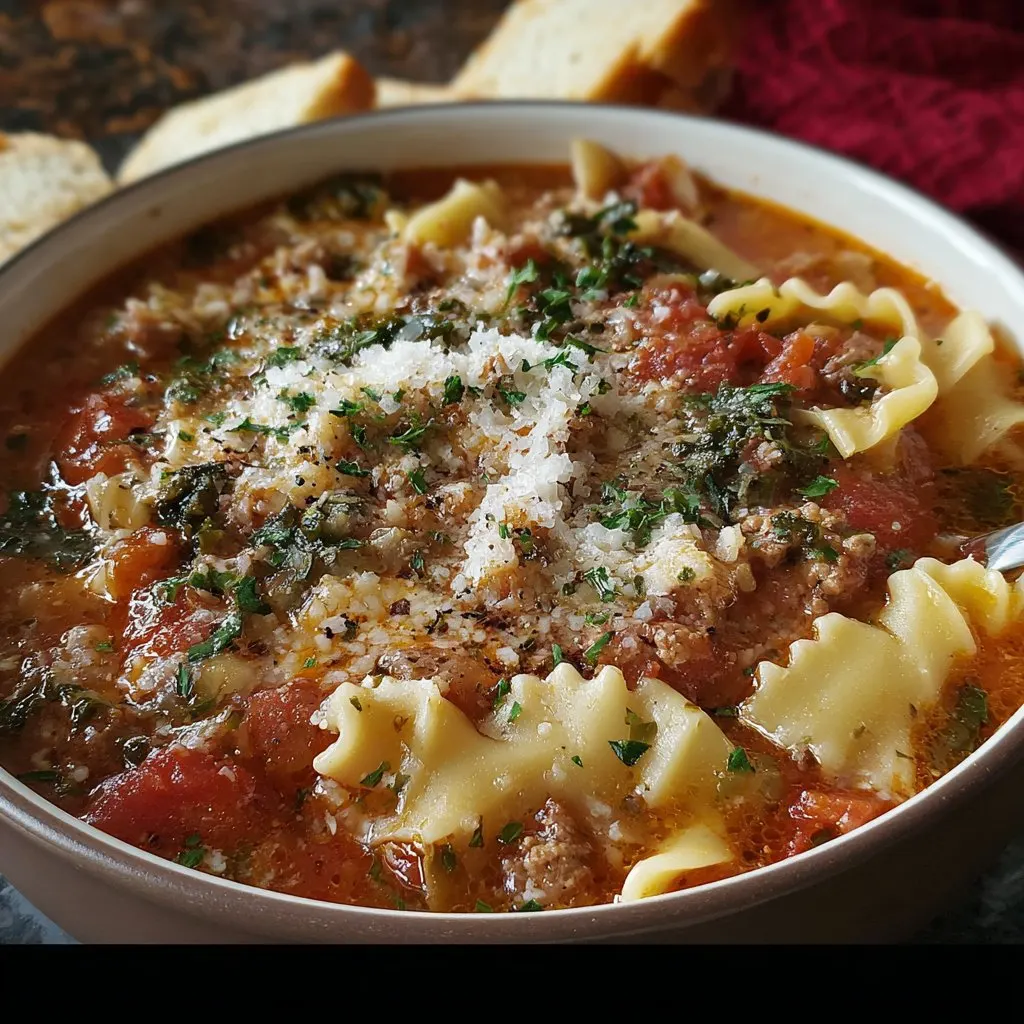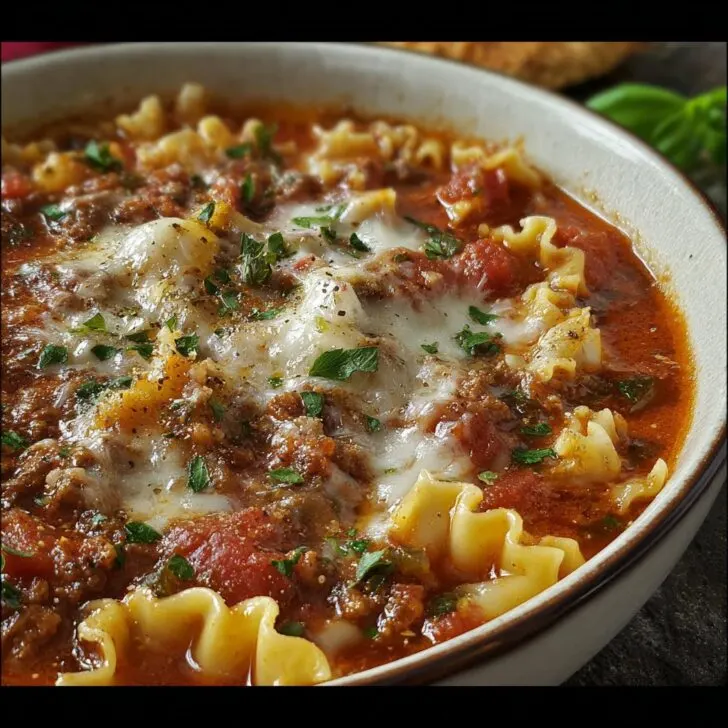How I Stumbled Into Making Gluten Free Lasagna Soup
Alright, so I have to admit—this gluten free lasagna soup was born from pure laziness. One rainy night, I just couldn’t face wrangling sheets of gluten free pasta into a perfectly layered lasagna. And to be honest, my kitchen looked like a flour bomb exploded. So, soup it was! My first attempt tasted like—well, let's just say it was more like sad tomato water with noodles doing the backstroke. But after a few tweaks (and a minor meltdown involving a missing soup ladle), I finally nailed it. Now, it’s one of those recipes I make when I want all the cheesy, tomato-y comfort of lasagna without the actual faff. My neighbor once dropped by right as I was serving it and now she always texts me when it smells like "lasagna night"—I guess that's a win?
Why You'll Love This (Or, Why I Keep Coming Back to It)
I make this when it’s cold and I want something hearty, but also when I just don’t feel like doing a ton of dishes (I hate doing dishes; they multiply when you’re not looking, I swear). My family goes a bit bonkers for this because, well, it’s like lasagna you eat with a spoon. And if you’re dealing with the gluten free life, you know lasagna noodles often fall apart—but here, nobody notices if they do! (Actually, it’s probably better if they’re a little messy.) I also love that it freezes halfway decently, though honestly, I’ve never had enough leftovers to properly test that theory. Oh, and kiddos love dunking their bread in it—if you’ve got gluten free bread, that is.
Here’s What You’ll Need (And What I Swap In When I’m Out)
- 1 tablespoon olive oil (I’ve used avocado oil in a pinch—it’s fine, just a slightly different vibe)
- 1 lb ground turkey or beef (sometimes I do half sausage, half ground meat for extra flavor, but my aunt only uses turkey and insists it’s better—up for debate)
- 1 large onion, diced (yellow’s classic, but honestly, red works if that’s what you have)
- 3-4 garlic cloves, minced (I won’t judge if you use the jarred stuff, promise)
- 2 teaspoon Italian seasoning (my grandma swears by McCormick, I just use whatever’s handy)
- ½ teaspoon dried basil (optional, but it does add a little something-something)
- ¼ teaspoon red pepper flakes (completely optional—skip if you’ve got spice-averse folks around)
- 1 can (28 oz) crushed tomatoes
- 4 cups chicken or veggie broth (carton or homemade, I’m not picky—just avoid anything too salty)
- 8-10 gluten free lasagna noodles, broken into rough pieces (I’ve used Jovial, Tinkyada, and honestly, even some gluten free penne when I was desperate)
- ½ cup ricotta cheese (if you don’t do dairy, you could skip or try a vegan ricotta, but I think it’s what makes the soup feel like lasagna)
- 1 cup shredded mozzarella (the more the merrier, in my house)
- ½ cup grated parmesan (or just a shake from the green can, if that’s what you’ve got—no judgment)
- Salt and pepper, to taste
- Fresh basil or parsley, for topping (totally optional, but makes it pretty for Instagram, haha)
How to Throw It All Together (Relax, It’s Easier Than Lasagna)
- Heat up your olive oil in a big ol’ soup pot (you know, the one that always feels a bit too big and heavy). Toss in your onions, sprinkle with a pinch of salt, and cook until they’re soft and kinda golden—about 5-7 minutes. This is where I usually sneak a taste, just to check for sweetness.
- Add in the garlic, Italian seasoning, basil, and red pepper flakes. Give it a stir until your kitchen smells amazing—about one minute.
- Push the veggies to the side and plop in your ground turkey or beef. Break it up with a wooden spoon (or whatever’s handy) and cook until it’s no longer pink. Don’t worry if it sticks a little; all that browned stuff just adds flavor. Actually, I find it works better if you let it sit for a minute between stirs.
- Pour in the crushed tomatoes and broth. Stir it all around, scraping the tasty bits off the bottom. Bring it up to a simmer. Now’s when it looks a bit weird, but don’t fret—it always comes together.
- Break your gluten free lasagna noodles into bite-ish pieces (doesn’t have to be perfect, mine are always kinda odd-looking). Chuck them in. Simmer for about 12-15 minutes. Check after ten; gluten free noodles can be drama queens and go mushy if you turn your back too long.
- Season with salt and pepper. Once the noodles are just tender, drop in your ricotta and half the mozzarella. Stir gently so it looks creamy but not totally melted in.
- Ladle into bowls and sprinkle with the rest of your mozzarella and parmesan, plus basil or parsley if you’re feeling fancy. Now, stand back and admire your work (or just dig in, who am I to judge?).
Notes (aka Things I Learned The Hard Way)
- Gluten free noodles can turn to mush if overcooked—set a timer, trust me.
- If you add all the cheese at once, it vanishes into the soup. Not a huge deal, but it’s less lasagna-esque.
- I once let the soup sit too long before serving and the noodles absorbed half the broth. It was still good, just more like a stew. So if you like it brothy, serve pretty quick after noodles are done.
- Oh, and don’t forget to taste for salt at the end—tomatoes can vary a lot in saltiness.
Variations (Some Wins, Some Flops—Here's What I’ve Tried)
- Vegetarian version: Swap the meat for lentils or a can of white beans. Works a treat! (Just up the seasoning a little.)
- Dairy free: I tried a coconut-based ricotta once. Not my jam, but maybe you’ll like it.
- Extra veggies: Zucchini or spinach are easy to toss in for some green—just add near the end so they don’t disintegrate.
- One time I tried using gluten free spaghetti noodles snapped into pieces… would not recommend. Too slurpy!
Equipment (And What to Do If You Don’t Have It)
- Big soup pot—mine’s a Dutch oven, but any large pot will do.
- Wooden spoon (or honestly, a spatula, whatever’s around the kitchen at the time)
- Ladle—if you don’t have one, a big mug or even a measuring cup works. I’ve done it plenty of times.

How to Store It (Or, Will There Even Be Leftovers?)
Keep leftovers in an airtight container in the fridge for 2-3 days. The noodles might soak up more broth, but I just add a splash of water before reheating. Honestly, in my house, it never lasts more than a day, so storage is mostly theoretical for me. If you do freeze it, the texture of the noodles gets a little wonky, but it’s still tasty in a comforting, not-so-photogenic way.
How I Like to Serve It (Family Quirks Included)
We always sprinkle a bit more parmesan and fresh basil on top, and sometimes I serve it with a side of gluten free garlic bread (okay, it’s just toast with garlic butter, but don’t tell my kids). If it’s just me, I’ll eat it standing at the counter, straight from the pot—don’t judge. My cousin likes it with a dash of hot sauce, which I thought was weird at first, but actually, it’s pretty great.
Pro Tips, Learned the Hard Way
- I once tried to rush simmering the soup and the flavors just weren’t there. Take your time—10-15 minutes makes a big difference.
- Add the noodles after the soup is already simmering, or you’ll end up with a weird texture. Trust me, I’ve tried it both ways.
- If your cheese clumps, stir more gently and in batches. Or just embrace the cheese blobs—they taste good anyway.
FAQ—Real Questions I’ve Actually Gotten
- Can I make this ahead? Sure, but the noodles will keep soaking up broth. Sometimes I keep the cooked noodles separate and just add them when I reheat. Or just live with it being extra thick—still delicious.
- Is there a way to make it spicier? Oh totally! Add as much red pepper as your tastebuds can handle. Or, try a spicy Italian sausage instead of plain meat.
- What brand of gluten free noodles do you use? I usually grab Jovial if I see it, but any kind works. Here’s a handy pasta comparison if you’re curious.
- Can I freeze it? Technically yes, but the noodles get a bit soft. If you do freeze it, check out these freezer soup tips—lots of good ideas!
- Is this soup healthy? Well, it’s got veggies, protein, and you can even use low fat cheese. It’s comfort food, so I say, enjoy it!
- What if I don’t like ricotta? You can just skip it, or sub in cottage cheese. It’s not quite the same, but in a pinch, it works.
- Wait, isn’t soup supposed to be runny? Sometimes this comes out kinda thick, especially if you let it sit. Just add more broth or water—no biggie.
So, that’s my gluten free lasagna soup. If you give it a go, let me know how it turns out! Or send me a pic—unless it’s a total disaster, in which case, commiserate with me and we’ll swap kitchen fail stories. And if you’re ever looking for more gluten free ideas, Minimalist Baker has a ton I lean on all the time.
Ingredients
- 1 tablespoon olive oil
- 1 pound ground turkey or beef
- 1 small onion, diced
- 3 cloves garlic, minced
- 1 teaspoon dried basil
- 1 teaspoon dried oregano
- 4 cups gluten free chicken broth
- 1 (24-ounce) jar gluten free marinara sauce
- 8 ounces gluten free lasagna noodles, broken into pieces
- 1 cup ricotta cheese
- 1 cup shredded mozzarella cheese
- Salt and pepper to taste
- Fresh basil, for garnish
Instructions
-
1Heat olive oil in a large pot over medium heat. Add diced onion and cook until softened, about 3 minutes. Stir in minced garlic and cook for 1 minute.
-
2Add ground turkey or beef to the pot. Cook, breaking it up with a spoon, until browned and cooked through. Drain excess fat if needed.
-
3Stir in dried basil, dried oregano, salt, and pepper. Pour in chicken broth and marinara sauce. Bring to a gentle boil.
-
4Add broken gluten free lasagna noodles to the pot. Reduce heat and simmer for 15-20 minutes, stirring occasionally, until noodles are tender.
-
5Ladle soup into bowls. Top each serving with a dollop of ricotta cheese, a sprinkle of mozzarella cheese, and fresh basil. Serve hot.
Approximate Information for One Serving
Nutrition Disclaimers
Number of total servings shown is approximate. Actual number of servings will depend on your preferred portion sizes.
Nutritional values shown are general guidelines and reflect information for 1 serving using the ingredients listed, not including any optional ingredients. Actual macros may vary slightly depending on specific brands and types of ingredients used.
To determine the weight of one serving, prepare the recipe as instructed. Weigh the finished recipe, then divide the weight of the finished recipe (not including the weight of the container the food is in) by the desired number of servings. Result will be the weight of one serving.
Did you make this recipe?
Please consider Pinning it!!


